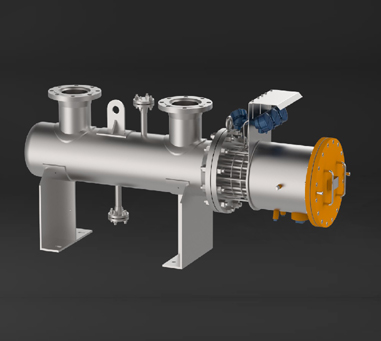제품정보

Circulation Heater
- 순환 히터의 일반적인 응용 분야로는 공정 용수, 비누 및 세제 용액, 보일러 및 온수기 등의 가열이 있습니다.
제품 사양
제품 상세 설명
A circulation heater is a combined unit of an Electric heater bundle inserted inside a Pressure vessel or shell, in which fluid will be flowing continuously. It is a compact heating system with fast heating of the process fluids.
The Circulation heaters are designed in such a way that cold process fluid enters the pressure vessel through the inlet nozzle at a low temperature, passes through the active zone of the heater bundle, and leaves the vessel through the outlet nozzle at desired high temperature. The system is designed in such a way that heating element skin temperature and the pressure drop across the nozzles are maintained within permissible limits. The Circulation heater system can be designed in single-stage vessels or multi-stage vessels based on the process requirements. The System can be installed vertically or horizontally based on the requirement and space availability.
Advantages
- Environment-friendly design. No hazardous gas/smoke/emission from the system.
- Compact design for quick heating of continuous flow.
- Can be used for short-duration operation as well as continuous operation.
- Precision Temperature control
- Can be accommodated in small footprints.
- Custom designed to meet specifications.
- Highly energy efficient and provide maximum dielectric strength.
- Compatible with standard industry piping and safety standards.
- Reliable design
- Easy to operate and maintenance-friendly
- Energy Saving
- Rating
From 1kW to 5000kW (Max) in Single Bundle or combination
- Design Temperature
-40 deg C to 650 degrees C
- Design Pressure
Up to 350 bar(g)
- Pressure Vessel
LTCS/CS/SS, Alloy steel
- Heating Element
A mineral filled insulated Heating Elements or Tubular heating Elements with Ni-Cr (80-20) as heating Coil and suitable outer sheaths
- Control System
Thyristor Control Panel + Local Control Stations for effective temperature control & safe operation. ( Safe area or Hazardous area)
- Terminal Enclosure
As required (Weatherproof or Flameproof)
- Installation
Horizontal/Vertical
- Certifications
Will be provided based on the requirement ( U, U2, PED, ATEX, IEC Ex, CCOE, DOSH, etc)
- Protection and Control
Element Skin Temperature controls, Process temperature control, Earth leakage protection, Overload current protection
Construction
Typical Circulation heaters are made of below-listed parts.
Terminal Enclosures — The Design of terminal enclosure changes based on the area of installation (Safe or hazardous). The Terminal enclosure is designed to protect the terminals of the individual elements from external impacts, such as dust, moisture, etc, and to facilitate the connection of the Incoming power supply to the heater bundle. Marathon flameproof heaters are certified to install in hazardous area zone 1 &2, Gas group IIC, IP 66
Heater Bundle: Consist of No. of U Pin heating elements adequately supported by a set of Baffles & Tie rods, designed to deliver the specified temperature at the outlet by maintaining the element temperature & pressure drop within the safe limits. Heating elements can be fixed to the heater flange by means of standoff sleeve pipes with brazing or direct welding or by means of threaded couplings. The heat duty of a bundle can be divided into many subgroups (banks) based on process conditions. This will help in better control and flexibility in the operation.
Pressure Vessel: A pressure Vessel or heater housing is a fabricated shell in accordance with ASME or equivalent international standards. The Vessel has an inlet and outlet nozzle for the process fluid to flow. The Vessels are also provided with a drain & vent nozzle for maintenance & safe operation purposes. The Vessel can be designed for either horizontal or vertical installation with single-stage or multistage configuration. It is recommended to have the vessel insulated so as to avoid excess heat loss and also to protect from any thermal shock.
Temperature Sensors: The Heater bundle will have an Element skin temperature sensor for monitoring and regulating the Element skin temperature within the limits. The Unit may also need additional sensors such as Tube sheet Temperature Sensor, Terminal Box Sensor, vessel Body temperature sensor, and process fluid Temperature sensors based on case-to-case. The Sensors used for the system will be certified in accordance with the area of installation.
The Temperature sensors are Typically RTD or Thermocouple. A simple heater bundle can also be controlled using Thermostat protection for skin & process temperature. If the Operation pressure is High, It is recommended to have a PSV (Pressure Safety Valve) installed within the Heater Vessel as an additional safety measure.
Control Panel: Heater controls Panels are designed to monitor & control the operations of the heater bundle also to ensure the safety of the equipment and operations.
The control logic can be either ON/OFF (contactor) or regulated (Thyristor) or a combination of both in a single panel. The control panels can be installed in both safe areas & hazardous areas by following respective design guidelines & certification requirements.
The Control Panels are provided with various indication systems such as Power ON, Heater ON-OFF, Trip, High Temperature, etc for comfortable handling of the process. The Temperatures of Elements, Process fluid & other areas (with sensors) are displayed on the Panel for better monitoring & awareness. Control Panel will also have safety interlocks such as high element temperature, Earth fault, process over-temperature, etc along with Emergency stop access for the safe operation and control.
Application | Solution Type | Alkaline or Acid Content | Recommended Sheath Material | Recommended Vessel Material |
Water | Clean water | Ph6 to ph8 | Copper / SS / Alloy | SS |
Mild solution | Process Water Weak Solutions Demineralized, De-ionized Water | pH5 to pH9 (2 - 3%) 5 - 6% | SS / Alloy 800 series
| SS SS SS |
Corrosive Solutions | Corrosive Solutions, Acid mixed solutions, Alkaline mix solutions | 5 -15% 10 - 25% 30 - 60% | SS / Alloy 800 series Titanium | SS SS SS |
oil | Low Viscosity Oils Medium Viscosity Oils High Viscosity Oils (Fuel Oil) |
| SS / Alloy 800 series SS / Alloy 800 series SS / Alloy 800 series
| CS/ SS CS/ SS CS/ SS |
Air | Medium Temperatures to 750°F High Temperatures to 1400°F |
| SS / Alloy 800 series | CS/ SS
|
Gas / Gas mix | Medium Temperatures to 750°F High Temperatures to 1400°F |
| SS / Alloy 800 series | CS/ SS
|
Application Areas
- Oil & gas
- Refinery & petrochemicals
- Gas processing plants
- Air separation unit
- Power plants
- Oil heating skid
- Fuel gas /natural gas skids
- Vaporizers



